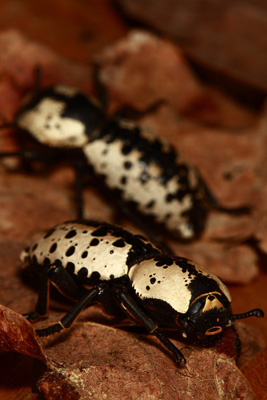 |
 back to Ironclads and Cylindrical Bark Beetles back to Ironclads and Cylindrical Bark Beetles
Diagnostic Features
Identifying Ironclad and Cylindrical Bark Beetles
The family Zopheridae is an extremely diverse assemblage of beetles that, at one time or another, have been a part of 3 separate families (Monommatidae, Zopheridae, Colydiidae). Due to this tremendous heterogeneity, it can often be difficult to correctly identify a zopherid based on any consistent set of diagnostic features.
In general, zopherids possess the following features: antennae 9-11 segmented with a usually abrupt, 1-3 segmented club, antennal insertions concealed from above, closed mesocoxal cavities, 4-4-4 or 5-5-4 tarsal formula, heteromeroid trochanters, and a tenebrionoid aedeagus (male genitalia).
Due to the great diversity within the group, it is useful to state the diagnostic features of the subfamilies and tribes found in North America to better help separate identifiable groups.
Note: the characters listed can be regarded as superficial and cannot be applied to all members of the group on a worldwide scale. The characters given below should be used strictly for the fauna found in North America.
Colydiinae
4-4-4 tarsi (also found in Pycnomerus in Zopherinae) (sometimes appearing 3-3-3), antennal insertions concealed from above, antennae 10- to 11-segmented with an abrupt 1-3 segmented club, open procoxal cavities (most) or with closed procoxal cavities (some; if closed, then apex protibia bearing a stout, curved spine); procoxae usually narrowly separated.
Zopherinae
5-5-4 tarsi (except 4-4-4 in Pycnomerus), closed procoxal cavities (most); procoxae usually broadly separated; eyes narrower, extending well onto dorsal surface of head (except eyes round in Pycnomerus).
Colydiinae
- Tribe: Colydiini: Includes the North America genera: Aulonium and Colydium.
Diagnostic features: With paired, lateral carinae on pronotum; eye emarginated, with canthus (also in some Synchitini); apex of protibia bearing a stout, curved spine; antennae 11-segmented with 3 segmented antennal club; procoxal cavities closed.
- Tribe: Synchitini: Includes the North America genera: Acolobicus, Antilissus, Bitoma, Colobicus, Coxelus, Denophloeus, Endeitoma, Eucicones, Eudesma, Lasconotus, Lobogestoria, Lyreus, Megataphrus, Microprius, Microsicus, Namunaria, Neotrichus, Paha, Phloeonemus, Pseudocorticus, Stephaniolus, Synchita.
Diagnostic features: This is a very diverse group and difficult to diagnose. In most cases, apex of protibia lacking a stout, curved spine (except present in Lasconotus); antennae 10-11 segmented with a 1- or 2-segmented club (3-segmented in Lasconotus, some Bitoma); antennae lacking scale-like setae; procoxal cavities open (closed in Lasconotus).
- Tribe: Adimerini: Includes the North America genus: Monoedus.
Diagnostic features: Tarsomere 1 greatly enlarged, often concealing tarsomere 2 or 2+3; antennae 10-segmented with a small, 1-segmented club.
- Tribe: Rhagoderini: Includes the North America genus: Rhagodera.
Diagnostic features: Wingless; narrow hind-coxae;antennae 11-segmented with weak, gradual, 3-segmented club; antennae with scales.
- Tribe: Nematidiini: Includes the North America genus: Nematidium.
Diagnostic features: Long, cylindrical body; mandibular bases exposed; antennae 11 segmented with 2-segmented club; procoxal cavities closed.
Zopherinae
- Tribe: Zopherini: Includes the North America genera: Zopherus, Sesaspis, and Phloeodes.
Diagnostic features: body large, constricted between prothorax and pterothrax; antennae 9-10 segmented; eyes extending well onto dorsal surface of head but not nearly meeting; hypomeron with at least some development of an antennal cavity; procoxal cavities closed; scutellum not visible; tarsal formula 5-5-4.
- Tribe: Pycnomerini: Includes the North America genus: Pycnomerus.
Diagnostic features: Body small, parallel-sided, glabrous, often shiny; eyes not extending well onto dorsal surface of head; hypomeron lacking antennal cavities; procoxal cavities closed; elytra with distinct puncture rows/striae; tarsal formula 4-4-4.
- Tribe: Phellopsini: Includes the North America genus: Phellopsis.
Diagnostic features: body large, constricted between prothorax and pterothrax; antennae 11-segmented; eyes extending well onto dorsal surface of head but not nearly meeting; hypomeron lacking antennal cavities; procoxal cavities open; scutellum visible; tarsal formula 5-5-4.
- Tribe: Usechini: Includes the North America genera: Usechus and Usechimorpha.
Diagnostic features: body smaller, constricted between prothorax and pterothrax; antennae 11-segmented with a 3-segmented club; pronotum with distinctive dorsal antennal grooves; eyes extending well onto dorsal surface of head but not nearly meeting; dorsal surface with setae; tarsal formula 5-5-4.
- Tribe: Monommatini: Includes the North America genera: Hyporhagus, Spinhyporhagus, and Aspathines.
Diagnostic features: body oval, dorsally convex, glabrous; procoxal cavities open; eyes extending well onto dorsal surface of head, nearly meeting; 4 abdominal ventrites connate; hypomeron with distinct antennal groove to receive antenna.

|
 |

Zopherus nodulosus haldemani
© N.P. Lord
|
 |



